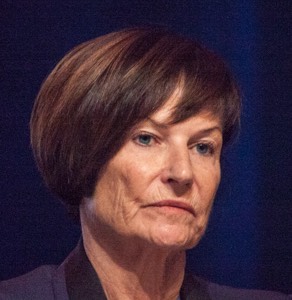
Judge Kathleen O’Malley
In re: Natural Alternatives, LLC, 2015-1911 (opinion and errata) is a non-precedential but still notable case from the U.S. Court of Appeals for the Federal Circuit that finds the claims of a patent that was in reexamination to be patentable, despite the examiner and the Patent Trial and Appeal Board finding that the claims were obvious. The patent itself – U.S. Patent No. 6,080,330 – is directed to an environmentally-friendly composition used for deicing and preventing ice formation on road surfaces.
Procedurally, a licensee of the patent filed three third party requests for reexamination. The examiner found a substantial new question of patentability and merged those three reexamination proceedings into one. The examiner held the challenged claims invalid as obvious in view of three primary prior art references. On appeal to the Board, the Board affirmed the examiner’s rejections of claims 1- 23 and 25-55 of the patent as obvious in view of those references. The Board also affirmed the examiner’s rejection of representative claim 6 based on the disclosure in one of the references, and rejected Natural’s objective indicia of nonobviousness. Natural moved for rehearing of the Board’s decision, but the Board denied Natural’s request, leading to this appeal to the Federal Circuit.
The Federal Circuit panel of Judges Newman, Clevenger, and O’Malley, reversed the Board’s determinations. Judge O’Malley delivered the opinion for the panel.
Regarding Judge O’Malley’s opinion, of note here is that the Federal Circuit reiterated that, in reexamination, the examiner bears the initial burden to come forward with a plausible rejection. While the examiner had cobbled together various references to make an obviousness rejection, the examiner failed to set forth “sufficient facts” supporting his position that the prior art disclosed the limitations of Natural’s claims in a manner that renders the claimed invention obvious. This was in part due to the fact that one of the prior art references taught an ingredient for its composition having 50% sugar, and that this “directly contradicts” Natural’s teaching that its process “removes most, but not all” sugar during its process.
According to the Federal Circuit, that discrepancy warranted explanation, but none was provided by the examiner and hence the examiner had not fulfilled his initial burden. Since the Board also ignored the same teaching regarding 50% sugar when it affirmed the examiner, it too failed to sufficiently bridge the gap with explanation. The Federal Circuit thus concluded that “[a]gainst this express teaching of the prior art, it was improper for the Board to assume, without citing evidence, that there is no material difference between” the prior art’s ingredient and Natural’s critical ingredient, or that part of the process for making both must be the same.
Also of note is that the Federal Circuit observed that the Board pointed to no evidence when making another critical finding about why one of skill in the art would have understood a particular teaching from a reference to be modifiable, particularly since that reference was explicitly disparaged by Natural’s patent. Instead, the Board merely concluded without evidence that a person of ordinary skill in the art would have “optimized” the amounts of various ingredients in the reference to achieve the claimed invention and asserted that such “optimization” would have been obvious.
“The Board, however, never made any findings regarding the level of skill of an ordinarily skilled artisan in the field. And as noted above, [the reference] taught the use of” an ingredient containing sugar, not an ingredient similar to the one that was the subject of Natural’s patent that had most of its sugar removed. “[T]his difference is critical” since Natural’s ingredient was a “primary” one for its claimed composition. “The Board could not simply assume, without explanation, that [the reference] was directed to the same composition.” Therefore, the Board erred in concluding that an ordinarily skilled artisan would have modified the references as alleged to arrive at the proposed combination and hence achieve Natural’s invention.
This case seems to continue something of a minor trend in obviousness cases that puts more of an emphasis on evidence for reasons to combine references, and in this respect appears to be creating a bit of a resurgence of the TSM test. The proponent of a rejection should not merely allege that there is a reasonable expectation of success for a proposed combination, or that it would be common sense to extrapolate such things. Instead, the Federal Circuit is signaling that there should be more than just a subjective belief, as proven using evidence. If this is, in fact, a new trend that is developing with the Federal Circuit, it would certainly be welcomed by patent applicants and patent owners.

![[IPWatchdog Logo]](https://ipwatchdog.com/wp-content/themes/IPWatchdog%20-%202023/assets/images/temp/logo-small@2x.png)

![[Advertisement]](https://ipwatchdog.com/wp-content/uploads/2024/04/Patent-Litigation-Masters-2024-sidebar-early-bird-ends-Apr-21-last-chance-700x500-1.jpg)

![[Advertisement]](https://ipwatchdog.com/wp-content/uploads/2021/12/WEBINAR-336-x-280-px.png)
![[Advertisement]](https://ipwatchdog.com/wp-content/uploads/2021/12/2021-Patent-Practice-on-Demand-recorded-Feb-2021-336-x-280.jpg)
![[Advertisement]](https://ipwatchdog.com/wp-content/uploads/2021/12/Ad-4-The-Invent-Patent-System™.png)







Join the Discussion
One comment so far.
Eric Berend
October 4, 2016 02:15 pmIt almost seems as if there actually are individual Judges within the Fed. Circuits and CAFC that have become aware of the sharp tilt from slightly favorable towards patentees, to strongly against, in a mere handful of years; and, are ‘pushing back’ in a somewhat subtle manner.
As an individual inventor with a potential “keystone” invention in energy production, dare I begin to consider engaging the U.S. Patent process (or, its WIPO section equivalent) in hopes that some space of actual Constitutional operation in the Courts, has now opened up?
To be sure, there seems to be nothing but antagonism and deliberate destruction of inventors’ Constitutional property rights emanating from the USPTO and the PTAB in particular; so, I consider that costs of litigation may well be a part of the overall expense, just to obtain a grant that is at least close to the correct basis and scope of claim protection.
But at least, there seems to be some legal cogency on a more correct basis here. Am I assuming too much?